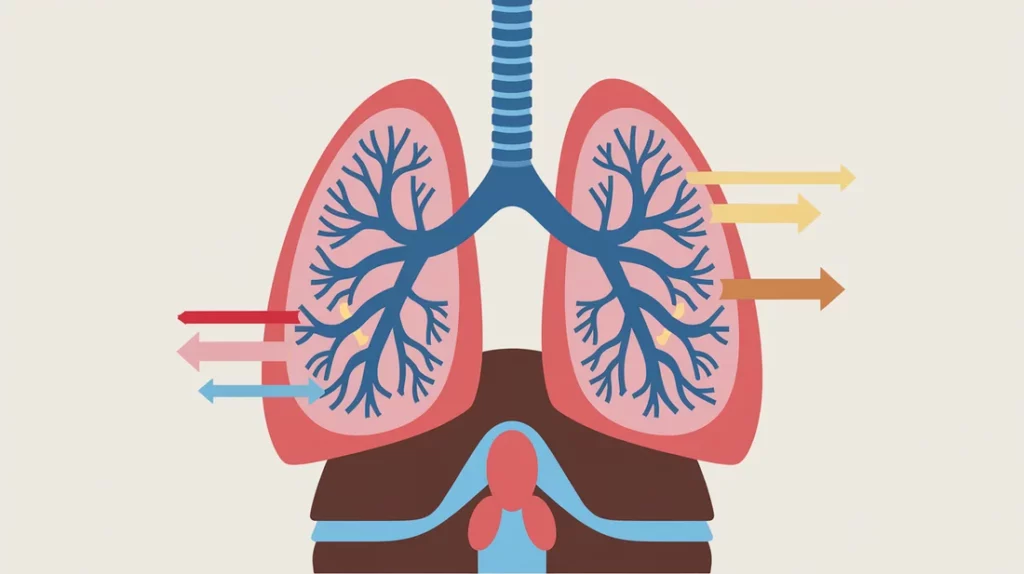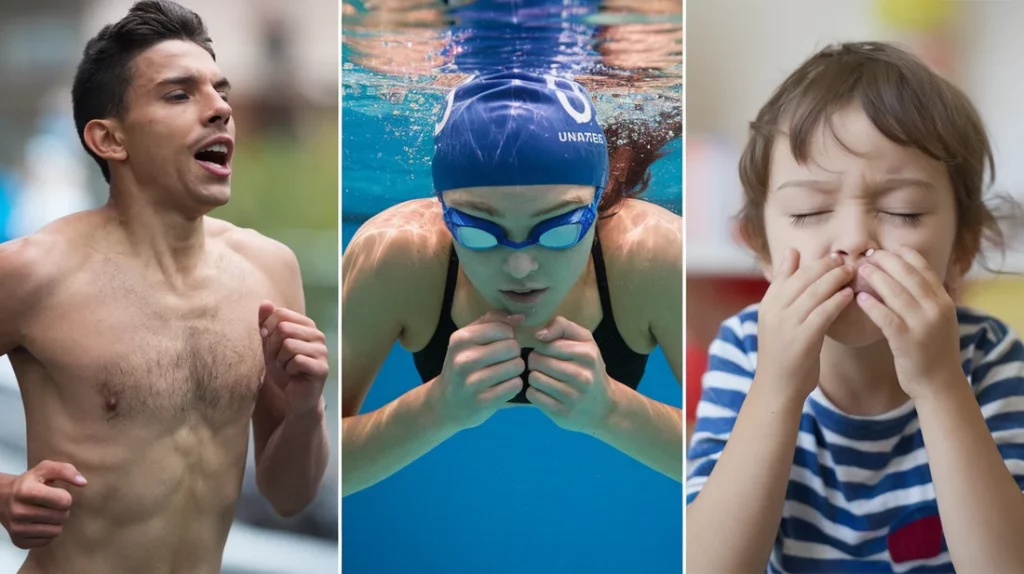Have you ever wondered what’s happening inside your body when you’re pushing your limits during a workout?
The truth is, the science of breathing and exercise is a fascinating and complex process, and it plays a vital role in determining how well you perform, how quickly you recover, and even how you feel overall.

This blog post will explore the connection between the method of breathing and exercise, and it will also help to explain exactly how your breath can transform your performance.
Understanding Basic Respiratory Physiology
To truly understand the impact of breathing on your exercise performance, it’s essential to first explore the basic anatomy and physiology of the respiratory system.
This complex system is vital for sustaining human life and is also the powerhouse for enabling you to perform any physical activity.
Let’s break down the key elements.

Key Concepts
- Anatomy of the Respiratory System:
- The respiratory system is composed of several organs that work in conjunction to allow us to take on oxygen and expel carbon dioxide. These include your lungs, which are the main organs of this system, as well as the diaphragm which is a large muscle that helps with breathing. It also includes your airways which are made up of the nasal passages, trachea, bronchi and bronchioles.
- These components play a vital role in the overall process of breathing and also in delivering oxygen to the body.
- Process of Gas Exchange:
- Gas exchange is a vital process of breathing, and occurs when oxygen is taken from the inhaled air, and is then passed into your bloodstream, while the waste product carbon dioxide is then transported to your lungs to be exhaled. This exchange happens within tiny air sacs called alveoli in your lungs.
- This transfer of oxygen into the bloodstream and carbon dioxide out of the bloodstream is essential for survival and also for performance during a workout.
- Role of Breathing in Energy Production:
- Breathing is also a vital component of energy production. Your body relies on oxygen to create ATP (adenosine triphosphate), which is used by your cells as fuel. This process is called cellular respiration, which is what gives you the energy to make your muscles contract.
- The entire process depends on your body’s ability to absorb oxygen, and the removal of carbon dioxide, to ensure that you are constantly creating new energy.
Understanding Basic Respiratory Physiology
To truly understand the impact of breathing on your exercise performance, it’s essential to first explore the basic anatomy and physiology of the respiratory system.
This complex system is vital for sustaining human life and is also the powerhouse for enabling you to perform any physical activity.
Let’s break down the key elements.
Key Concepts
- Anatomy of the Respiratory System:
- The respiratory system is composed of several organs that work in conjunction to allow us to take on oxygen and expel carbon dioxide. These include your lungs, which are the main organs of this system, as well as the diaphragm which is a large muscle that helps with breathing. It also includes your airways which are made up of the nasal passages, trachea, bronchi and bronchioles.
- These components play a vital role in the overall process of breathing and also in delivering oxygen to the body.
- Process of Gas Exchange:
- Gas exchange is a vital process of breathing, and occurs when oxygen is taken from the inhaled air, and is then passed into your bloodstream, while the waste product carbon dioxide is then transported to your lungs to be exhaled. This exchange happens within tiny air sacs called alveoli in your lungs.
- This transfer of oxygen into the bloodstream and carbon dioxide out of the bloodstream is essential for survival and also for performance during a workout.
- Role of Breathing in Energy Production:
- Breathing is also a vital component of energy production. Your body relies on oxygen to create ATP (adenosine triphosphate), which is used by your cells as fuel. This process is called cellular respiration, which is what gives you the energy to make your muscles contract.
- The entire process depends on your body’s ability to absorb oxygen, and the removal of carbon dioxide, to ensure that you are constantly creating new energy.
How Breathing Impacts Workout Performance
Now that you understand the physiological processes involved in breathing, let’s dive into the specific ways it can impact your workout performance.
Breathing is not just about staying alive, it’s a powerful tool for optimizing your body’s ability to perform and to enhance your overall fitness journey.

Key Points
- The Importance of Oxygen Delivery:
- The amount of oxygen you receive in your bloodstream, will directly impact your performance. When you use proper breathing techniques, you are ensuring that your muscles have a constant flow of oxygen, which is essential for your muscles to function properly, and also to prevent fatigue. Without the correct amount of oxygen, you will struggle to perform to the best of your ability.
- The way you breathe can determine how effectively you are able to deliver oxygen to your muscles, and is why it is so important to use a method that allows you to take deep and controlled breaths.
- Impact of Carbon Dioxide Removal:
- During exercise, your body produces carbon dioxide as a waste product, and it is crucial to expel this to keep your body functioning correctly. Proper breathing methods will help you to remove waste products such as carbon dioxide quickly, which will help to maintain a balanced blood pH level, and also improve your endurance and overall fitness.
- If your body does not expel carbon dioxide quickly, your body may start to struggle, and will not be able to perform at its optimum level.
- Role of Breathing in Energy Efficiency:
- Your body relies on oxygen to produce ATP (adenosine triphosphate) which is what it uses as fuel. The way you breathe will directly affect how efficiently this process takes place. By optimizing your breath, you are optimizing the amount of ATP your body can produce and ultimately, the amount of energy you have during a workout.
- By using methods such as diaphragmatic breathing, or paced breathing, you are improving your body’s natural ability to be efficient, which will help to enhance your performance and endurance.
Common Breathing Mistakes During Workouts
Even if you’re an experienced athlete, you may unknowingly be making some common breathing mistakes during exercise.
These mistakes can impact your performance, cause you to tire more quickly, and also affect your recovery.
Let’s explore some of these mistakes, so you know what to look out for.

Key Mistakes
- Shallow Breathing:
- Shallow breathing, which involves taking short and rapid breaths that do not fully engage your lungs, is a common mistake. This limits the amount of oxygen you receive, and also reduces the removal of carbon dioxide, which can lead to reduced stamina and also feelings of fatigue.
- This method is incredibly inefficient and is likely to cause you to tire much more quickly. To rectify this, you should be focusing on taking slow, deep and deliberate breaths.
- Holding Your Breath:
- Another common mistake is to hold your breath during intense movements. This is something that is commonly done when you are pushing yourself to your limit, and while it may feel natural, it is also very harmful to the body.
- Holding your breath limits oxygen delivery to your muscles, which increases muscle tension, and also increases fatigue. It is important to breathe consistently through all movements to avoid this problem.
- Mouth Breathing:
- As we discussed earlier, mouth breathing can also lead to various problems. While it allows for a more open and less restricted passage of air, it also bypasses the nasal passages. This leads to less nitric oxide production, a dry mouth and airways and also an increased chance of airway infections due to unfiltered air.
- It is important to make a conscious effort to breathe through your nose, as often as you can, to ensure that you are performing at your best.
Frequently Asked Questions About Breathing and Exercise
To ensure you have a solid understanding of the connection between breathing and exercise, let’s address some of the most frequently asked questions.
These answers will provide further insight into the methods that we have been discussing, and will help you to better understand how breathing works.
- Question 1: How does breathing help with workout performance?
- Answer: Breathing is the key to unlocking better workout performance, as it plays a crucial role in delivering oxygen to your muscles and removing waste products like carbon dioxide. This then provides your muscles with the fuel they need to perform at their best, whilst also reducing any feelings of fatigue and tiredness. Proper breathing also helps to regulate stress hormones, and improve overall focus.
- Question 2: Why do we breathe faster when exercising?
- Answer: When you are exercising, your body requires more oxygen to produce energy. This increased need for oxygen causes your brain to signal your lungs to breathe faster, which will then provide your muscles with what they need. Your breathing also speeds up to remove the waste product, carbon dioxide, more effectively. The faster you breathe, the more efficiently your body is able to do this.
- Question 3: How does your breathing affect your workout?
- Answer: The way you breathe directly affects your workout performance. Proper breathing allows you to provide your muscles with the fuel they need for sustained energy, which will also help to improve your overall endurance, and also to reduce fatigue. The method of breathing you use can also have a direct impact on stress hormones and your overall well-being. The benefits of proper breathing are not to be ignored!
- Question 4: Is it better to breathe through your nose or mouth?
- Answer: The optimal method for breathing during exercise is through your nose, as this helps to filter, humidify and also warm the air that you are breathing in. The nose is also responsible for producing nitric oxide, which also helps to improve oxygen delivery. Mouth breathing bypasses these methods, making it a less effective option. If you are performing high intensity exercise, it is not uncommon to breathe through your mouth, but you should strive to always implement nasal breathing where possible.
Final Thoughts on Breathing and Exercise

As we reach the end of this in-depth exploration into the science of breathing and exercise, I hope you now have a much better understanding of the power that your breath can have on your fitness journey.
By implementing these key concepts, you are on your way to optimizing your performance, and also improving your overall well-being.
In this post, we have discussed the anatomy of the respiratory system, the vital role of oxygen and carbon dioxide exchange, and how your method of breathing affects your overall performance.
We have also discussed the common mistakes that people often make, and also practical ways to enhance your breathing.
This knowledge will help you to implement the correct methods for your workouts and ensure that you are giving your body what it needs to thrive.
I encourage you to begin to implement these changes today, and I also hope that you are now inspired to take control of your breath, to enhance your workouts, and also to improve your health.
The key to success is consistency and patience, and to also remain curious as you explore the world of breathing and how it links to athletic performance.
Now, go forth and breathe!
References
- The respiratory muscles during exercise – Provides an in-depth explanation of the connection between breathing and muscle metabolism during exercise, and how correct methods can improve performance. It highlights the importance of oxygen delivery and ATP production.
- Effects of respiratory muscle work on respiratory and locomotor blood flow during exercise – This is a scientific journal, which explores how breathing patterns directly impact muscle performance and blood flow. It emphasizes the importance of efficient breathing techniques.
Related Posts
No posts
